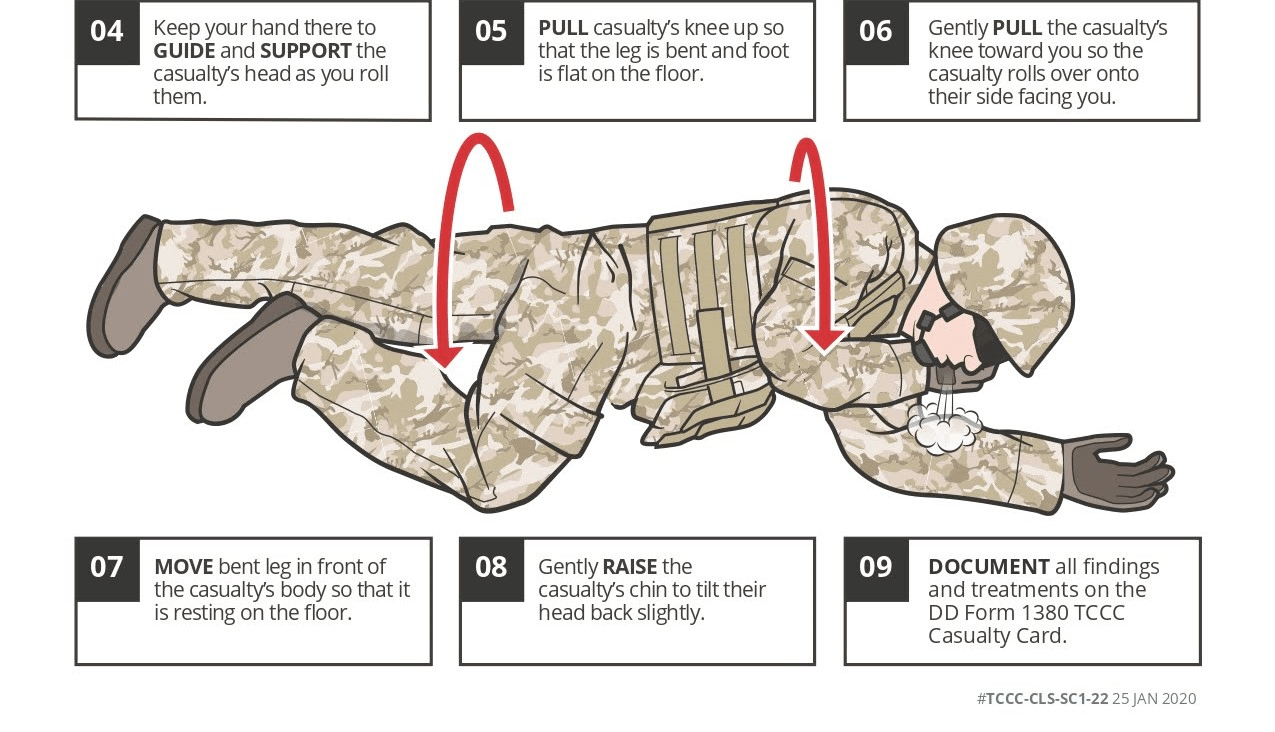Head Injuries
What are 2 key signs that a tourniquet is applied effectively?
The bleeding stops completely, and no distal pulse can be felt below the tourniquet.
What are two ways to open the airway? Once answered, demonstrate the one I tell you to...
Head-tilt-chin-lift & Jaw Thrust
When applying a chest seal- do you put it on in the inhale or exhale? Why?
Exhale! Because we want to get as much air out as we can (we don't want to trap air in)
Name 3 things we're assessing for in Circulation.
Pelvic Fractures, Pulses, Skin color, Cap refills
Why is preventing hypothermia important? List two actions to prevent field hypothermia.
To prevent SHOCK!!
Remove wet clothing, wrap casualty in insulating materials, keep off ground.
A casualty is unconscious, and another Soldier is waving energy drinks under their nose to “wake them up.” What’s the CLS move?
Insert an NPA, check airway and breathing—energy drinks won’t fix hypoxia.
What must you do after moving a patient?
Reassess ALL interventions
After applying a tourniquet and checking pulses. What should you do next?
WRITE DOWN THE TIME!
When using a BVM, how often are we giving a breath?
5-6 seconds !!
Name 3 signs and symptoms of a Tension Pneumothroax.
Difficulty breathing, shortness of breath, rapid pulse, distended jugular veins, absent rise and fall of the chest, bluish skin, chest pain, tracheal deviation
List 5 pulse sites
Carotid, radial, brachial, groin, pedal
What are some signs of an eye injury? Name 3.
Vision loss, impalement, pain, blood, bruising, lacerations
If a casualty starts singing while you're packing their wound, what should you do?
Keep packing—they're conscious, but that doesn't mean bleeding has stopped
Sing with them!
Tactical combat casualty care has three phases. List the phases in order.
1) Care under fire
2) Tactical field care
3) Tactical evacuation care
What is the purpose of hemostatic gauze? How long do we hold pressure for?
It promotes clotting. Hold pressure for 2-3 minutes.
Show me how to put someone in the recovery position.

List three things we're looking for during Respiration.
Signs of chest injury, quality of breathing, respiratory rate, open chest wounds, equal chest rise and fall
What scale do we use to measure a casualty's level of consciousness? And what does it stand for?
Demonstrate one of them..
AVPU! Alert, verbal, pain, unresponsive
When dealing with an eye injury, do you cover both eyes or just the injured one? And why?
ONLY the affected one because it prevents further injury and anxiety
After treating a casualty for massive bleeding, they become confused, pale, and their radial pulse is absent. What does this mean, and what is your priority?
They are in shock → cover them to prevent hypothermia and prepare for rapid evacuation
Name 5 items that come in an IFAK?
Tourniquets, combat gauze, chest seals, NPA, NCD, TCCC, sharpie, gloves
What are three parts of a rapid blood sweep?
Neck, armpits, groin
If a casualty is snoring but breathing, what does that tell you about their airway? What is your next step?
Their airway is partially blocked; insert an NPA
What does NCD stand for? And what is the placement for one?
Needle chest decompression. Between 2 and 3 intercostal space, mid-clavicular. Or 4 and 5 intercostal space anterior axillary line.
Show me how to put a pelvic binder on. What is the name or abbreviation of where the Pelvic Binder goes?
Greater Trochanter!!
List 5 signs and symptoms of a head injury.
Headache, pupil responses, vomiting, nausea, blurry vision, seizures, loss of consciousness, restlessness, confusion, slurred speech
You sealed a chest wound, but the casualty’s breathing gets worse, and their trachea starts to shift. What do you suspect and what should you do?
Tension pneumothorax → perform needle decompression.
What medications come in a Combat Pill Pack? What are they used for?
Meloxicam- Anti-Inflammatory
Moxifloxacin- Antibiotic
Acetaminophen- Pain
Name two signs that bleeding is life threatening.
Bright red spurting blood, pooling blood, soaked bandages, amputation
Your casualty has severe facial trauma. When assessing a casualty's airway, another CLS rockstar tells you to put an NPA in. What do you do?
NO! NPA's and facial trauma are NOT friends.
Tell me and show me the full sequence of steps for putting a Chest Seal on.
Expose the wound, wipe clean, apply occlusive seal on the exhale
What do we do with tourniquets during Circulation? Then demonstrate one.
Tourniquet replacement & tourniquet conversion
Do casualties with head injuries receive medications or anything orally (water, food)?
No, they don't receive sleepy meds because we won't be able to tell if their injury is worsening or if it's caused by medication. They also should not have anything orally because they may need surgery or they could throw up and choke
The second patient because it's the most life threatening and they may develop a tension pneumo
When applying a tourniquet, which direction should you twist the windlass? And why does it matter?
It doesn't matter- as long as it's tight enough to stop the bleeding.